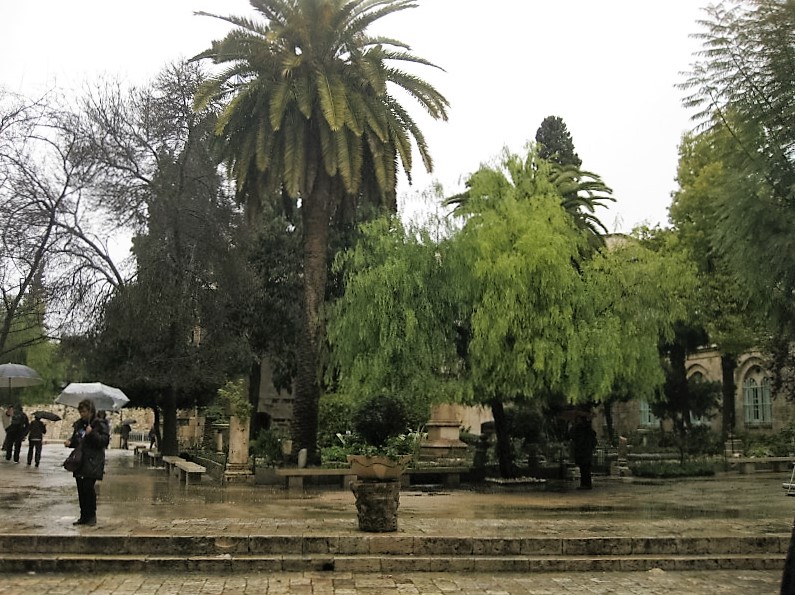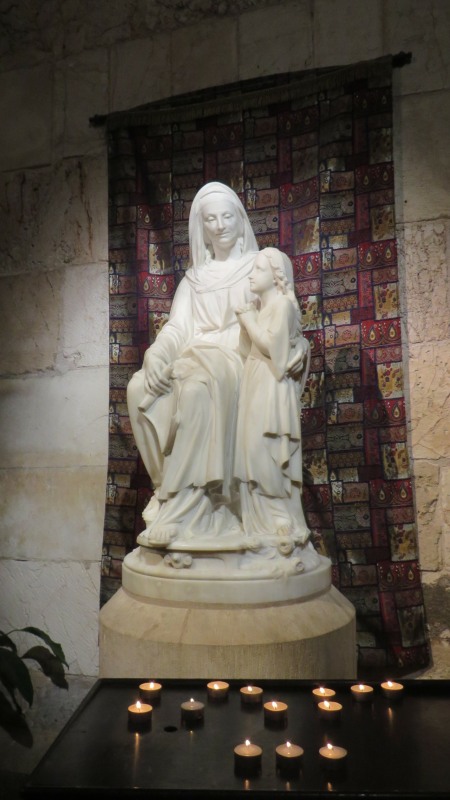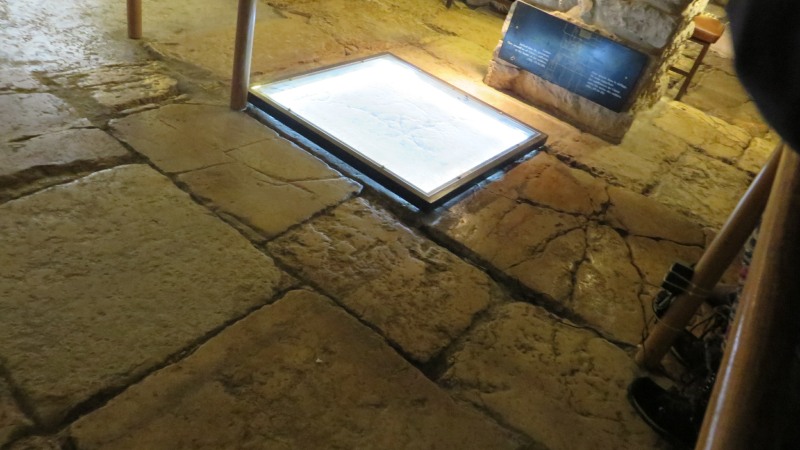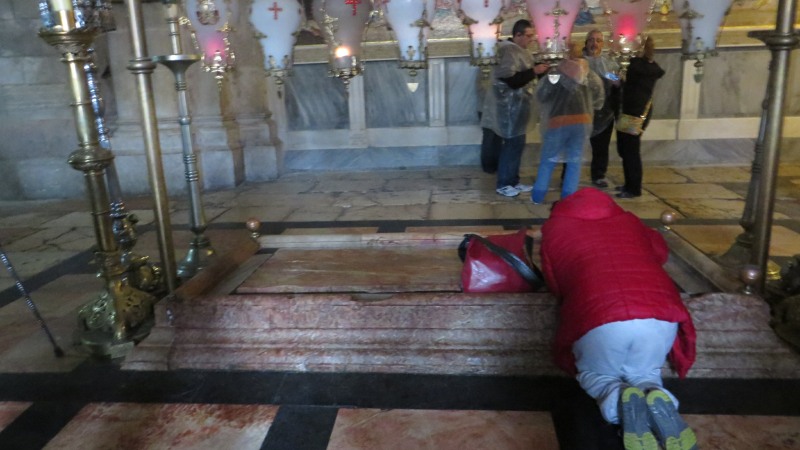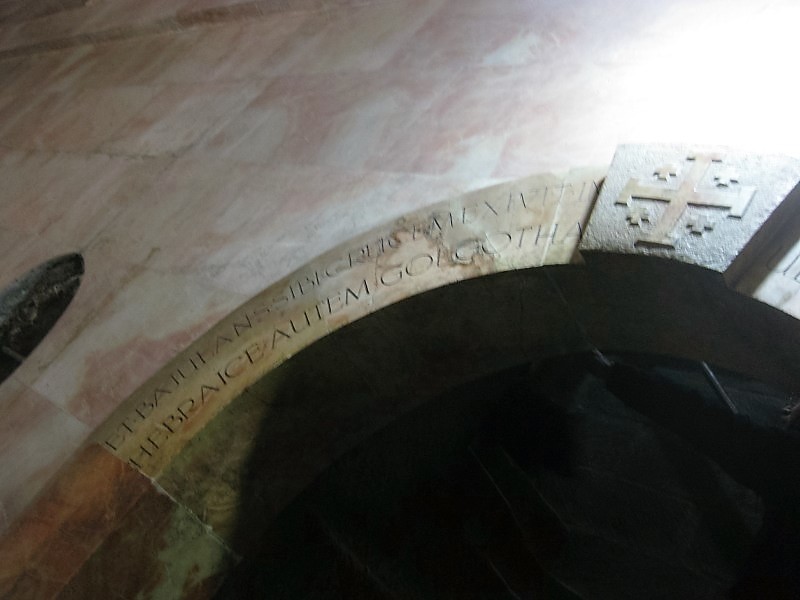Sunday - Rain day...
Enterprising street vendors offer to sell us umbrellas for a few dollars. Some of us gratefully succumb to their salesmanship. Those of us who have decided to walk into the old city, follow Ann as she guides us across puddles, down roads, to the Damascus Gate - instantly recognizable as the place of choice for reporters sending their news back to the UK. A shooting took place here on Friday whilst we were in Bethlehem - a sobering thought. We pass through the dog legged gateway, enjoying a brief respite from the rain, and emerge into the Muslim Quarter of the old city.
We make our way down the street to the Church of St Anne, where we meet up with the less mobile members of our group who have travelled by taxi. Passing through the arched gateway we enter the well cultivated grounds, just waiting to be explored. Amongst the planting stands a statue of Cardinal Lavigerie, the founder of the White Fathers who reside here. We are here to celebrate mass and are met by one of the resident priests who takes us into the retreat centre to the chapel used by the community. Thankfully, we peel off our wet layers and relax in the warmth of the room.
The chapel is simply decorated and peaceful, an intimate setting for our celebration. The gospel reading is from St Luke's Gospel in which Jesus calls his disciples to leave their fishing to follow him and spread God's message of love to others. The reading holds particular significance for us all in the light of the past week. How can we fulfil this call today in our daily lives? I sit and ponder the words in the quiet following the homily. From outside we can hear the sparrows squabbling amongst themselves. Clearly the rain has stopped, temporarily at least. I smile to myself thinking of the sparrows that joined us for mass on the Sea of Galilee. At communion we sing 'Bread of Life, Truth Eternal'. The words resonate within as I consider our week together, our shared experiences, the truth we have encountered.
Chapel and Church at St Anne's Gallery
After mass we have a chance to explore the grounds of the enclave. Excavations within the grounds have revealed a Crusader church overlying a Byzantine Church, which had been built over Roman remains. Within these there is evidence of two pools which were used to supply water to the Temple Mount. It is thought that these are the Pools of Bethesda mentioned in St John's Gospel. I follow a path and then metal steps and walkways working my way through the ruins. I peer over walls and into the ancient remains, struck by the depth of the excavations. Bernie and Terry join me and we continue down a steep flight of metal steps and find ourselves on the edge of a deep pool, part of a Roman cistern, incredibly well preserved. Climbing back up the steps, we see the location of the Southern Pool dating back to the 1st Century, the one mentioned in the Gospels. The whole site is full of historical significance, with ruins and columns, large blocks of stones and ancient carvings all over the place. I don't know how much of it has been documented, but there are not many indicators describing what we can see.
I make my way over to St Anne's Church. This Crusader church has survived the ravages of time pretty much intact as it was turned into an Islamic law school just after the Muslim conquest, eventually being given to the French at the end of the Crimean War. The building is quite plain to look at, but the acoustics are amazing! A Polish choir stands on the altar steps singing. Several of us stand entranced as we listen to their voices soaring harmoniously into the body of the church.
To one side of the church stands the statue of St Anne, the mother of Mary, after whom this church is named. Leaning against her leg is her daughter, Mary, the mother of Jesus. It dawns on me that this is a statue of Jesus's Grandmother..... I am quietly thrilled to think that the part that grandparents play is just as valid today as it was then.... Within her right hand is a scroll of parchment with words from the Book of Deuteronomy 'Diliges Dominum Deum Tuum' - 'Thou shalt love the Lord thy God'. These are the words which would have been passed on from Mother to Daughter to Son. Both Mary and Jesus were taught in the Jewish tradition. It's easy to forget this sometimes, but, as Usama has explained to us earlier in the week, recalling this fact helps us understand the teachings of Jesus and his attitude to the Jewish Authorities of his day.
Leaving the church, we gather under the gateway for a few minutes shelter from the rain, which has started again, before turning right, out of the gates and join the road, the Via Dolorosa - the Way of Sorrow.
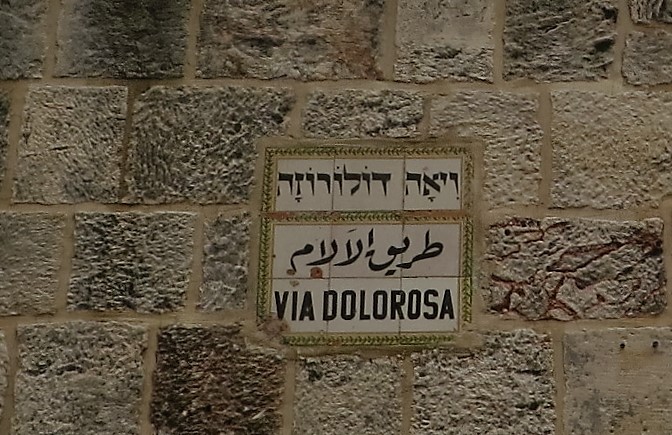
We stop at the Church of the Flagellation, which is in the grounds of a Franciscan Monastery. This is where it is believed that Jesus was beaten up by the Roman soldiers. The church is small, but is full of symbolism of the agonies that Our Lord suffered. A large stained glass window behind the altar shows Jesus being flogged and having a crown of thorns placed on his head. Another window shows Pontius Pilate washing his hands and a third shows Barrabas rejoicing at his release. The dome above the altar has a mosaic showing a crown of thorns. The light holders, suspended from the roof by metal chains, look like nails. The door is studded with what look like large metal nail heads. Outside, the doorway has an arch above it with a stone carving of winding thorns. Above the door is what looks like a metal grille, reminiscent of a jail cell. The whole effect reminds us of the torture and suffering Jesus endured for us.
Moving on we arrive at the Ecce Homo Convent of the Sisters of Zion. This remarkable building contains large sections of Roman remains revealed when the convent was constructed. These include a large cistern cut out of the rock, one of a chain of reservoirs providing water to the city in Roman times.
Passing down stairways and along narrow passages we come to an extensive area of paving. Inscribed on the pavement are various shapes which have been cut into the stone by soldiers, these formed the basis for various games played by the soldiers, one of which has been identified as the King's Game. It is thought that this was the game that was played when soldiers stripped Jesus, dressed him in a scarlet robe, placed a crown of thorns on his head, put a reed in his hand and mocked and struck him - for this is the 'Lithostrotos' or 'Gabbatha', as it is named in the Gospel of St John, the pavement, where Jesus was judged before Pilate. We gather to pray and reflect on the sufferings of Jesus, before exploring the area more fully.
There is a further stretch of paving spreading across the whole width of the building. This was grooved by the Romans to stop horses slipping on it. I walk along it, conscious that Jesus would have walked along this route. I turn to go back to the entrance. On the wall facing me is a life sized mosaic of Christ carrying his cross......... if this was then, what would I do? Would I join the mob shouting for Jesus to be crucified? Would I turn away and hide, terrified that a similar fate awaited me? Would I stand and watch in horror at the events unfolding before me? Or would I follow in his footsteps along with his mother and those who did not abandon him.......?
Emerging into the cold light of day, we continue to make our way along streets slick with rain, passing other points along the route designated as stations of the cross - a small chapel commemorating the first fall has a papier mâché relief depicting the scene; an ancient stone indentation purported to be a place that Jesus placed his hand as he carried his cross; odd doorways with signs or stone carvings above them; lettering on walls.
More people are in evidence now, as pilgrim groups follow the same route as us. Shops and stores have opened; rain runs in runnels off the roof awnings above us onto the street below, making the surface slick and slippery in places; street vendors call out their wares; there is a constant to-ing and fro-ing of people. This busy, noisy atmosphere re-enacts the atmosphere of the city during Jesus's walk to Calvary - life continued around him, indifferent to the momentousness of events taking place in front of their eyes... it may even have been raining too!
Eventually we find ourselves back at the plaza in front of the Church of the Holy Sepulchre. Within the church lie the last few stations.
We enter the church and immediately in front of us, is a large slab of rock where pilgrims are kneeling and praying. This is the Stone of Anointing commemorating where Jesus was anointed before his burial. It is not the original stone though, dating back to just 1810.
Ann leads us to the Chapel of St Mary Magadalen, which is one of the Catholic chapels. The geometrical patterns on the floor and in various areas of the whole church identify areas under the ownership of the 'Latins' or Catholic Church. As had been explained to us yesterday, the whole church is shared between several different Christian traditions, each jealously guarding their right to their area.
Ann recommends that we visit the tomb chamber first, as the queue is relatively short at present, so we queue up and wait patiently alongside the small building in which it is to be found. The slow movement of the queue comes to a standstill for several minutes as priests from the Greek Orthodox tradition and then the Coptic tradition take turns to incense the interiors of the sepulchre and then their altars.
We move forward again, quietly. Countless hands have worn smooth the corner of the marble pedestal supporting a column by the entrance to the tomb. Huge candles and thuribles of incense at the entrance to the tomb fill the air with their sweet perfume. I enter the tomb.
I am inside a chamber, the Chapel of the Angels. In the centre, on a pedestal, is a piece of rock, believed to be a piece of the stone which covered the entrance to the tomb. Moving forward, I stoop to pass through a very low doorway and enter a second room. The small chamber is filled with the warmth of candles. To my right lies a marble slab marking the place where Jesus lay. I gently touch it.....There is no blinding light, no flash of inspiration, no amazing revelation, just a place of quiet, a questioning, the phrase - 'My Lord and My God'.
I walk back out into the body of the church, thoughtfully.
Church of the Holy Sepulchre Gallery - Edicule
Crossing over to the corner on the right of the main entrance, a group of us ascend steep steps through an archway to the place of the crucifixion, Golgotha. Scaffolding has been erected in places as a programme of restoration continues to take place.
There are crowds of people here, some waiting quietly, patiently; others weaving their way between and in front of people in the queue. Above us, mosaics cover the ceiling with scenes from the bible or of various saints. To our right is the Frankish chapel of the tenth station - Jesus is stripped of his garments. In front of us is a mosaic of the eleventh station - Jesus is nailed to the Cross. The twelfth station is on our left in the ornate Greek Orthodox chapel. The first thing we see on entering is a statue of Our Lady of Sorrows, with a sword piercing her heart. To one side of it under cover of glass, is part of the bedrock of the hill on which Jesus was crucified. It is split by a large crack. Under the altar itself, is a metal circle denoting the exact place where the cross was erected. I kneel and place my hand there. Feeling rather shaken, I leave the chapel.
Descending some stairs I meet up again with some of the group, a couple of us make our way to the Chapel of Adam, immediately below the 12th station. Here you can see the lower part of the rock, with the continuation of the massive crack descending even deeper.
After our busy, thought-provoking morning, we decide it is time for lunch. After which, some of us choose to explore further, but I take the easy option to return to the hotel for a hot bath, dry clothes and a hot chocolate. Afterwards, I bump into Clare and Justine who have spent more time exploring the city and then the Church of the Holy Sepulchre, discovering some of its hidden chapels in the depths of the building.
That evening a few of us cross the road and visit the bar at the American Colony. A culture shift takes place as we enter the place - a roaring log fire burns in the hearth, leather sofas and comfy seats surround tables in various alcoves, quiet conversation and the chink of glass upon glass - it could almost be a pub back in the UK..... It seems weird to be sitting in such a place in Jerusalem...
We wander back to the hotel for dinner, after which we gather together in the bar for a final drink and a security talk from Ann about what we are likely to encounter at the airport as we try to leave the country.
Day 3 - For Nothing is Impossible to God
Day 4 - The Prophet of the Most High
The thoughts and impressions stated are those of the writer only and may not reflect the feelings and opinions of others in the group.

